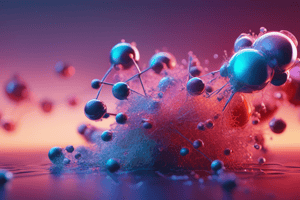Podcast
Questions and Answers
Which of the following atoms can be a free radical?
Which of the following atoms can be a free radical?
- Oxygen (correct)
- Carbon
- Hydrogen
- Nitrogen
What is the defining characteristic of a free radical?
What is the defining characteristic of a free radical?
- Independent existence
- Covalent bond formation
- High chemical reactivity (correct)
- Abstracting or donating an electron
What happens when a covalent bond between entities is broken?
What happens when a covalent bond between entities is broken?
- Atoms combine to form a compound
- Atoms lose an electron
- Atoms gain an electron
- Atoms become free radicals (correct)
What is the consequence of excessive or uncontrolled generation of free radicals?
What is the consequence of excessive or uncontrolled generation of free radicals?
What is the key feature of free radicals that explains their biological activities and cell damage?
What is the key feature of free radicals that explains their biological activities and cell damage?
Which of the following is NOT a major reactive oxygen species (ROS)?
Which of the following is NOT a major reactive oxygen species (ROS)?
What is the impact of lipid peroxidation reactions on biological systems?
What is the impact of lipid peroxidation reactions on biological systems?
What is the role of oxidative stress in damage and disease?
What is the role of oxidative stress in damage and disease?
Which of the following provides protection against reactive oxygen species (ROS) formation and damage?
Which of the following provides protection against reactive oxygen species (ROS) formation and damage?
What are the major antioxidant vitamins?
What are the major antioxidant vitamins?
Flashcards are hidden until you start studying
Study Notes
Free Radicals
- Any atom or molecule with an unpaired electron can be a free radical.
- The defining characteristic of a free radical is having an unpaired electron, making it highly reactive.
Bond Breakage and Free Radicals
- When a covalent bond between entities is broken, free radicals are formed.
Consequences of Free Radicals
- Excessive or uncontrolled generation of free radicals can lead to oxidative stress and cell damage.
- The key feature of free radicals that explains their biological activities and cell damage is their high reactivity due to the unpaired electron.
Reactive Oxygen Species (ROS)
- Major ROS include superoxide, hydroxyl radical, and hydrogen peroxide, but not carbon dioxide.
- Lipid peroxidation reactions, driven by ROS, can alter biological membranes, disrupt cellular function, and cause damage.
Oxidative Stress and Disease
- Oxidative stress, resulting from an imbalance between ROS production and antioxidant defenses, contributes to damage and disease.
Antioxidants and Protection
- Antioxidants, such as vitamins C and E, provide protection against ROS formation and damage by neutralizing free radicals.
- The major antioxidant vitamins are vitamins C and E, which play a crucial role in maintaining cellular health and preventing oxidative stress.
Studying That Suits You
Use AI to generate personalized quizzes and flashcards to suit your learning preferences.





